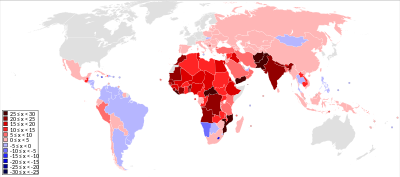
Back الفروق بين الجنسين في التعليم Arabic Dallimet gjinore në arsimim Albanian Статеві відмінності в освіті Ukrainian
This article is written like a personal reflection, personal essay, or argumentative essay that states a Wikipedia editor's personal feelings or presents an original argument about a topic. (January 2023) |

| Part of a series on |
| Sex differences in humans |
|---|
| Biology |
| Medicine and health |
| Neuroscience and psychology |
| Sociology |

Sex differences in education are a type of sex discrimination in the education system affecting both men and women during and after their educational experiences.[1] Men are more likely to be literate on a global average, although higher literacy scores for women are prevalent in many countries.[2] Women are more likely to achieve a tertiary education degree compared to men of the same age. Men tended to receive more education than women in the past, but the gender gap in education has reversed in recent decades in most Western countries and many non-Western countries.[3]
- ^ Pearson, Jennifer. "Gender, Education and." Blackwell Encyclopedia of Sociology. Ritzer, George (ed). Blackwell Publishing, 2007. Blackwell Reference Online. 31 March 2008 <http://www.blackwellreference.com/subscriber/tocnode?id=g9781405124331_chunk_g978140512433113_ss1-16>
- ^ Davies, Bronwyn (2007). "Gender economies: literacy and the gendered production of neo-liberal subjectivities". Gender and Education. 19 (1): 1–20. doi:10.1080/09540250601087710. S2CID 143595893.
- ^ Van Bavel, Jan; Schwartz, Christine R.; Esteve, Albert (16 May 2018). "The Reversal of the Gender Gap in Education and its Consequences for Family Life". Annual Review of Sociology. 44 (1): 341–360. doi:10.1146/annurev-soc-073117-041215. ISSN 0360-0572. S2CID 13717944.
© MMXXIII Rich X Search. We shall prevail. All rights reserved. Rich X Search